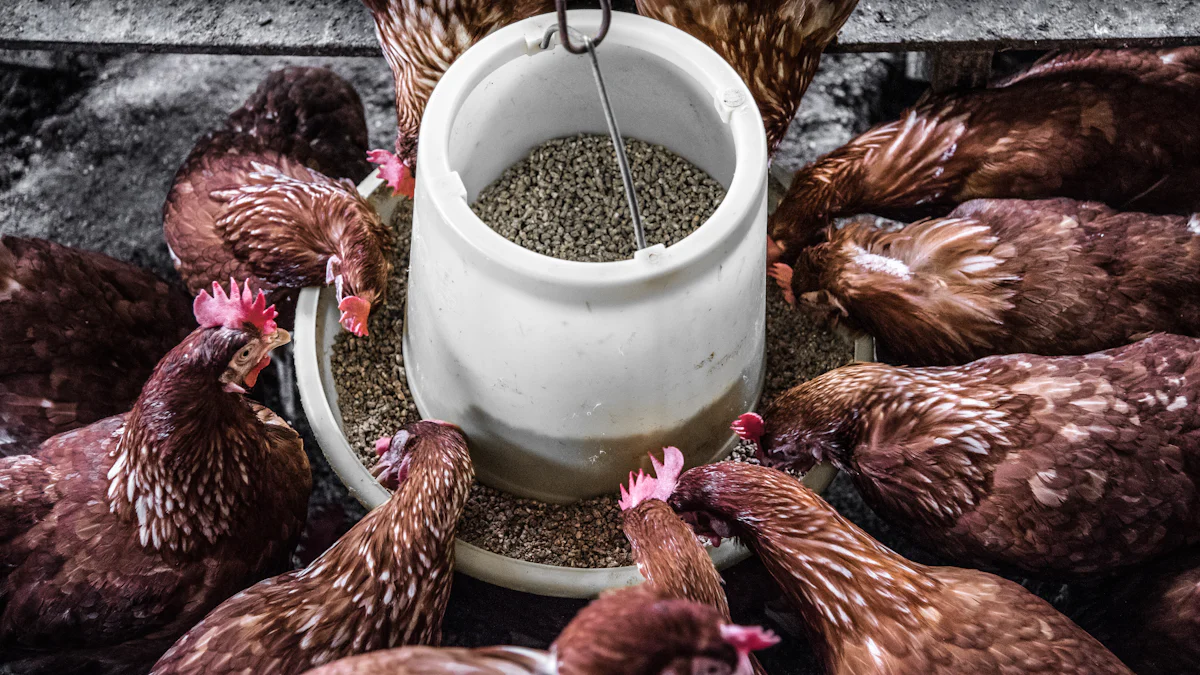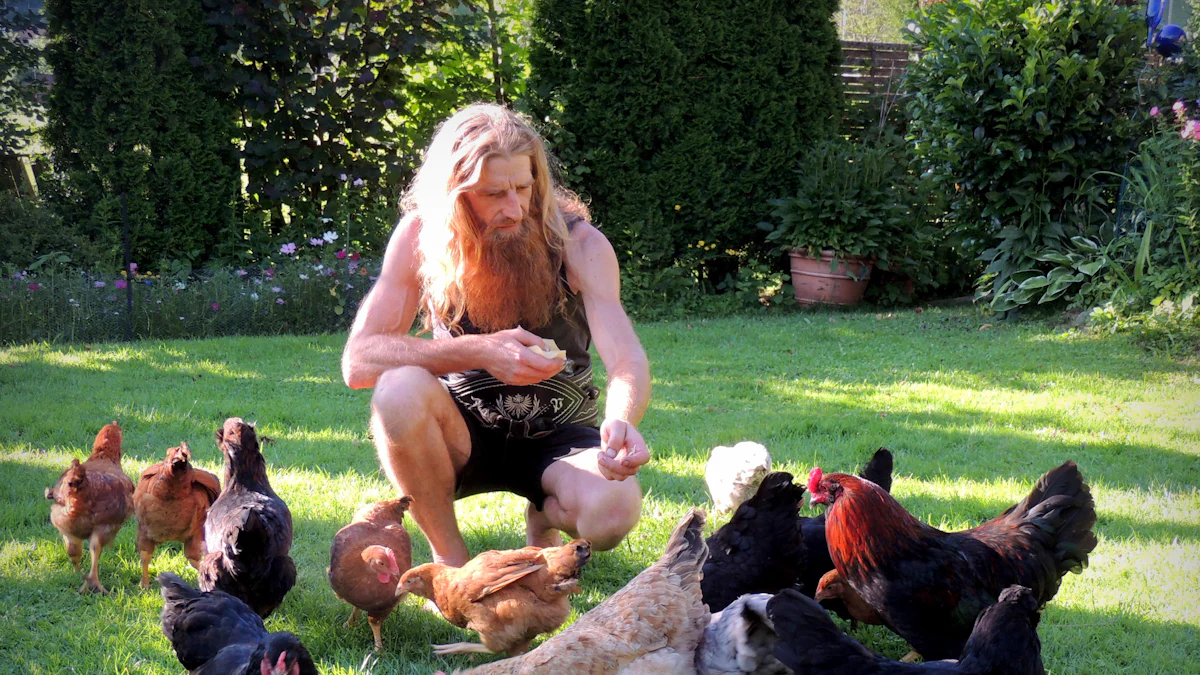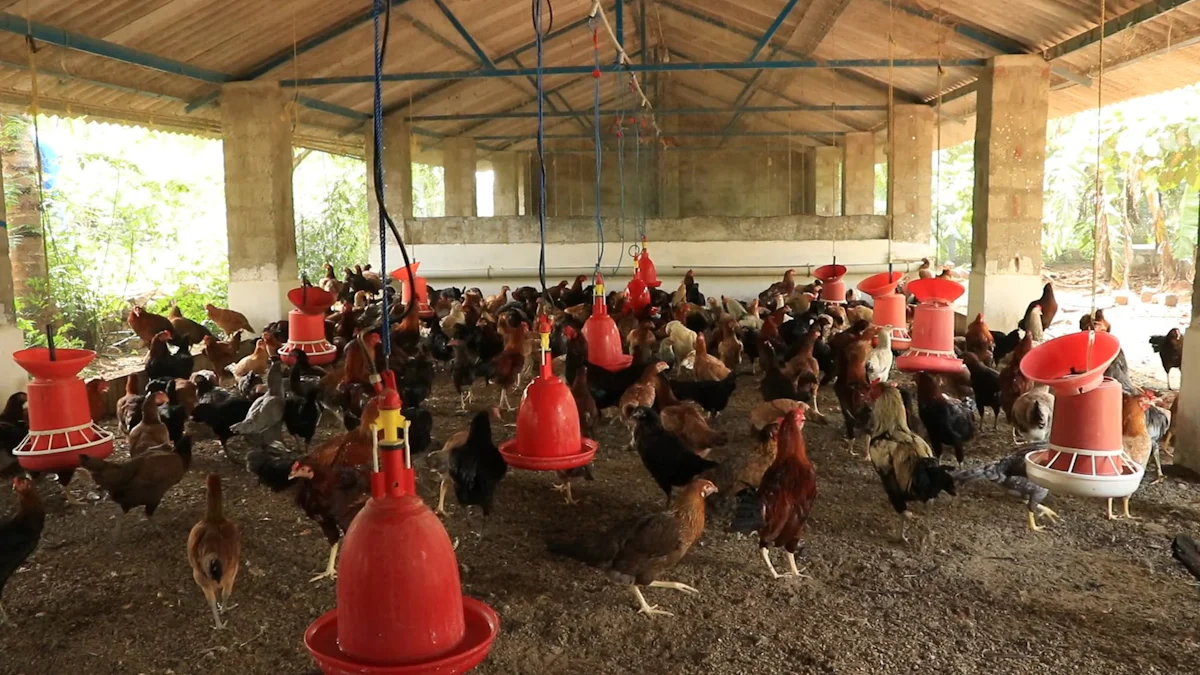
Dried Mealworms fo Chickens are an excellent way to enhance their nutrition while keeping your flock content. These small yet powerful treats are loaded with high protein—up to 60%—and essential vitamins such as B1, B2, and B12. They also deliver important minerals like calcium and iron, which are crucial for maintaining your chickens’ overall health. However, it’s important to feed them in moderation; Dried Mealworms fo Chickens should make up no more than 10% of their diet to prevent nutritional imbalances. Whether you’re helping them through molting, promoting natural foraging behavior, or simply offering a tasty reward, Dried Mealworms fo Chickens are a convenient and effective option.
Key Takeaways
- Dried mealworms are a healthy snack for chickens. They have up to 60% protein and important vitamins.
- Only give a small amount of dried mealworms. They should be no more than 10% of your chickens’ food to avoid health problems.
- Toss mealworms on the ground to let chickens search for them. This keeps them busy and happy.
- Use dried mealworms as rewards to train chickens and make them trust you.
- Keep dried mealworms fresh by storing them in sealed containers or freezing them. This keeps them safe for your chickens.
Benefits of Dried Mealworms for Chickens

Nutritional Advantages
High Protein Content
Protein is a cornerstone of your chickens’ diet, and dried mealworms deliver it in abundance. With about 50% protein content, these treats far surpass grains like corn or wheat, which offer much less. This makes dried mealworms an excellent choice for supporting egg production, growth, and feather quality. If you want richer yolks and healthier hens, adding these protein-packed snacks to their diet can make a noticeable difference.
Essential Vitamins and Minerals
Dried mealworms for chickens aren’t just about protein—they’re also loaded with essential vitamins like B1, B2, and B12, along with minerals such as calcium and iron. These nutrients play a vital role in boosting your flock’s immune system and overall health. By incorporating mealworms into their diet, you’re giving your chickens the tools they need to thrive.
Behavioral Benefits
Encourages Foraging
Chickens love to scratch and peck, and dried mealworms are perfect for encouraging this natural behavior. When you scatter mealworms on the ground, your flock will instinctively start searching for them, mimicking their wild foraging habits. This activity keeps them physically active, mentally stimulated, and less prone to boredom or stress.
Builds Trust with Chickens
Using dried mealworms as treats can help you bond with your flock. Chickens quickly associate these tasty snacks with positive interactions, making them more comfortable around you. Whether you’re training them to come when called or coaxing a shy hen into the coop, mealworms are a great way to build trust.
Seasonal Benefits
Supports Molting and Egg Production
Molting can be a stressful time for chickens, but dried mealworms provide the extra protein they need for feather regrowth. This high-protein snack also supports egg production, especially during winter when hens may lay less due to environmental stress. By supplementing their diet with mealworms, you’re helping them stay healthy and productive year-round.
Provides Energy in Cold Weather
Cold weather can sap your chickens’ energy, but dried mealworms offer a quick and nutritious boost. Their high protein and fat content provide the extra calories your flock needs to stay warm and active during chilly months. It’s a simple way to keep your chickens happy and healthy, even when temperatures drop.
How to Feed Dried Mealworms to Chickens

Feeding Methods
Scatter on the Ground
One of the easiest ways to feed dried mealworms to your chickens is by scattering them on the ground. This method encourages natural foraging behavior, which keeps your flock active and entertained. Toss a handful of mealworms around their coop or run, and watch them eagerly scratch and peck to find every last morsel. It’s a fun way to keep them busy while promoting their instinctive habits.
Mix with Regular Feed
Another effective method is to mix dried mealworms with your chickens’ regular feed. This adds variety to their diet and ensures they get a balanced meal. Simply sprinkle a small amount of mealworms into their feed container and stir it in. This approach works well if you want to avoid overfeeding treats while still giving your flock a protein boost.
Use Treat Dispensers or Toys
For a more interactive option, try using treat dispensers or toys designed for chickens. These devices release mealworms as your chickens peck or push them, providing both mental stimulation and a tasty reward. It’s a great way to keep your flock entertained, especially during colder months when they might spend more time indoors.
Portion Sizes and Frequency
Recommended Daily Amounts
When feeding dried mealworms for chickens, portion control is key. Aim to provide about 10-25 grams of mealworms per chicken daily. This amount should not exceed 10% of their total diet. Mealworms are a supplement, not a replacement for their regular feed, so keep the portions small to maintain a balanced diet.
Feeding Frequency Guidelines
Treats like dried mealworms should be given in moderation. If your chickens consume about half a cup of feed daily, limit mealworms to one tablespoon per day. Overfeeding can lead to obesity and nutritional imbalances, so it’s best to stick to these guidelines. Offering mealworms two to three times a week is a good starting point.
Special Feeding Considerations
Feeding Chicks vs. Adult Chickens
Chicks and adult chickens have different dietary needs. For chicks under eight weeks old, introduce mealworms cautiously. Their digestive systems are still developing, so offer mealworms only once or twice a week in very small amounts. Pullets, or young chickens nearing maturity, can have mealworms more frequently as a treat. Adult chickens, on the other hand, can enjoy mealworms regularly since they require more protein and fat for egg production.
Adjusting for Weather or Stress
Your chickens’ needs may change depending on the weather or their stress levels. During cold months, you can slightly increase the amount of dried mealworms to provide extra energy. If your flock is molting or recovering from stress, mealworms can help them regain strength thanks to their high protein content. Always monitor your chickens’ health and adjust their diet as needed.
Tips for Feeding Dried Mealworms
Maximizing Benefits
Combine with Other Feeds
You can get the most out of dried mealworms by combining them with other feeds. This approach ensures your chickens enjoy a balanced diet while still benefiting from the high protein content of mealworms. Here are some tips:
- Gradually introduce dried mealworms into their diet to avoid upsetting their digestion.
- Mix mealworms with their regular feed instead of replacing it entirely.
- Use mealworms as occasional treats to enhance their overall nutrition.
By mixing mealworms with grains, vegetables, or fruits, you can create a more diverse and nutritious meal for your flock.
Use as a Training Reward
Dried mealworms are perfect for training your chickens. They’re tasty, nutritious, and easy to handle. Follow these steps to use them effectively:
- Establish Trust: Start by offering mealworms from your hand. This helps your chickens associate you with something positive.
- Teach Basic Commands: Once they’re comfortable, introduce simple commands like “come” or “here.” Reward them with a mealworm when they respond correctly.
- Encourage Positive Behaviors: Reinforce good habits, such as returning to the coop or staying in specific areas, by giving them a treat immediately after they behave as desired.
Training with mealworms not only builds trust but also makes managing your flock easier.
Proper Storage and Handling
Storing Mealworms Correctly
Proper storage keeps dried mealworms fresh and safe for your chickens. Here’s how you can store them:
- Freeze mealworms at temperatures below -15°C to extend their freshness for over six months.
- Use airtight containers or plastic bags to prevent moisture and pests.
- If freezing isn’t an option, store them in a cool, dark cupboard using a tight-sealing container.
Freezing is the best method, but a dark, cool cabinet works well for short-term storage.
Identifying Spoiled Mealworms
Spoiled mealworms can harm your chickens, so it’s important to check them regularly. Look for signs like mold, an unusual smell, or a change in texture. If you notice any of these, discard the mealworms immediately. Always inspect them before feeding to ensure they’re safe.
Avoiding Overfeeding
Balancing Treats with a Healthy Diet
While dried mealworms are nutritious, overfeeding can lead to problems. They’re calorie-dense and should only make up about 10% of your chickens’ diet. Balance their treats with a mix of grains, vegetables, and fresh water. This variety ensures your flock gets all the nutrients they need.
Monitoring Chicken Health
Keep an eye on your chickens’ health to avoid issues from overfeeding. Watch for signs of obesity, like reduced activity or difficulty moving. Regularly check their weight and egg production. If you notice any changes, adjust their diet accordingly. Feeding dried mealworms in moderation helps maintain a healthy and happy flock.
Precautions and Alternatives to Dried Mealworms
Precautions
Avoid Over-reliance on Mealworms
Dried mealworms are a fantastic treat, but relying on them too much can cause problems for your chickens. They don’t provide all the nutrients your flock needs. For example, mealworms lack enough calcium, which is essential for strong eggshells. Overfeeding them can lead to nutritional imbalances and even health issues over time.
To avoid this, keep these tips in mind:
- 🐔 Feed mealworms in moderation. They should make up no more than 10% of your chickens’ diet.
- 🥬 Mix mealworms with other healthy treats like fruits, vegetables, and grains. This ensures your flock gets a variety of nutrients.
- 🍂 Provide grit and greens alongside mealworms to support digestion and overall health.
By balancing their diet, you’ll keep your chickens happy and healthy without over-relying on mealworms.
Check for Allergies or Sensitivities
Just like humans, chickens can have sensitivities to certain foods. While rare, some chickens might not tolerate mealworms well. Watch for signs like diarrhea, lethargy, or changes in behavior after introducing mealworms. If you notice anything unusual, stop feeding them and consult a vet. Always introduce new treats gradually to see how your flock reacts.
Alternatives
Fresh Mealworms
If you want to switch things up, fresh mealworms are a great option. They’re packed with protein and nutrients, just like dried ones. However, fresh mealworms contain more moisture, which can be beneficial for hydration. They’re also closer to what chickens would eat in the wild, making them a natural choice.
Black Soldier Fly Larvae
Black soldier fly larvae are another excellent protein source for chickens. They’re rich in nutrients and have a similar protein content to dried mealworms. Here’s a quick comparison:
| Source | Protein Content | Fat Content |
|---|---|---|
| Black Soldier Fly Larvae | Up to 50% | 35% |
| Dried Mealworms | 53% | 28% |
These larvae also contain more calcium, which is great for egg-laying hens. They’re an eco-friendly option too, as they’re often raised on food waste.
Protein-Rich Kitchen Scraps
Don’t overlook your kitchen! Scraps like cooked eggs, plain yogurt, or small amounts of meat can provide a protein boost. Just avoid feeding salty, sugary, or processed foods. These scraps are a budget-friendly way to supplement your chickens’ diet while reducing food waste.
By exploring these alternatives, you can keep your flock’s diet varied and nutritious while giving them the protein they need to thrive.
Dried Mealworms for Chickens are a fantastic way to boost your flock’s health and happiness. They’re packed with protein, essential for feather regrowth and egg production. These treats also encourage natural behaviors like foraging and help you bond with your chickens. Just remember to feed them in moderation. Gradually introduce mealworms into their diet and balance them with grains and layer pellets. Keep an eye on your chickens’ health to avoid overfeeding or nutritional imbalances. By following these tips, you’ll ensure your flock thrives while enjoying this nutritious treat.
FAQ
What are the best ways to feed dried mealworms to chickens?
You’ve got options! Scatter them on the ground to encourage foraging, mix them with regular feed for a balanced meal, or use treat dispensers for mental stimulation. Choose what works best for your flock’s needs.
Can I feed dried mealworms to baby chicks?
Yes, but only in small amounts. Chicks under eight weeks old have sensitive digestive systems. Offer mealworms sparingly—once or twice a week—and crush them into smaller pieces to make them easier to eat.
How do I store dried mealworms to keep them fresh?
Store them in an airtight container in a cool, dark place. For long-term storage, freeze them at -15°C or lower. This prevents spoilage and keeps pests away. Always check for mold or unusual smells before feeding.
How often should I give dried mealworms to my chickens?
Treats like mealworms should only make up 10% of their diet. Feed them 2–3 times a week or about one tablespoon per chicken daily. Overfeeding can lead to health issues, so moderation is key.
Are there alternatives to dried mealworms?
Absolutely! Try fresh mealworms, black soldier fly larvae, or protein-rich kitchen scraps like cooked eggs. These options provide variety and keep your chickens’ diet balanced. Plus, they’re budget-friendly and easy to find.
🐔 Tip: Rotate treats to keep your flock excited and ensure they get a range of nutrients!


